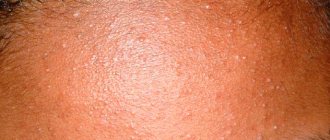Modern cosmetic procedures do an excellent job of treating age spots. At the same time, patients can choose tactics to their liking - be it hardware IPL or laser resurfacing procedures or injections of meso-cocktails with ascorbic acid.
Pigmentation can be present in a person from birth or acquired over the years.
Pigment spots do not harm the body as a whole, but they greatly disturb the aesthetics of the face. Previously, hyperpigmentation was characterized by the stereotypical term “liver spots,” and people with it on the face were considered sick in the hepatobiliary system. Indeed, the defect can arise from problems with the liver, but this is far from the only reason.
Here are a few reasons for the appearance of pigmentation:
- changes in the functioning of the thyroid gland, dysfunction of the thyroid gland;
- changes in the functions of the gallbladder and liver;
- excessive exposure to ultraviolet rays;
- hormonal imbalance in a woman’s body – pregnancy, taking hormonal medications;
- post-traumatic and post-burn factors;
- some skin diseases that are accompanied by low levels of melanin in some areas of the skin;
- Some medications, drugs and cosmetics can also contribute to the development of age spots.
How to deal with hyperpigmentation
Today there are many methods that will help even out skin color, but the purpose of one or another method depends on the severity of the problem and goals.
Unfortunately, if a person is predisposed to hyperpigmentation, then making the skin look young and even in color is quite difficult.
In cosmetology they use:
- special masks and creams with whitening effect;
- in some cases, peeling or grinding (acid or laser) is indicated;
- hardware IPL procedures.
Hardware methods are the most effective way to remove the appearance of pigment on the skin.
Age spots: what are they?
Skin color is determined by the pigment melanin, which is produced by melanocyte cells (do not confuse both of these terms with melatonin, a sleep hormone that has nothing to do with color).
The place of residence of melanocytes and melanin is the epidermis, that is, the upper layer of the skin. Melanocytes produce melanin granules and, through their processes, inject “grains” of this pigment onto the surface of the skin.
European women have less melanin in their skin, while representatives of the Negroid race have more. This pigment is also responsible for hair color, but that’s not about that now.
In general, the production of melanin in the epidermis is a beneficial process. This is how our skin is protected from ultraviolet radiation. Tanning, in fact, is the result of the active work of melanocytes for a defensive purpose.
But melanin can accumulate in certain areas of the skin. Then pigment spots form. This condition is also called hyperpigmentation.
Often pigment spots appear on the face, décolleté, back and arms.
The production of melanin is controlled by the pituitary gland, thyroid gland and gonads.
Types of skin pigmentation disorders
Lentiginosis.
A brownish pigmented spot on the skin that is the result of increased melanin deposition and an increased number of melanocytes. Color can vary from light brown to black. Solar lentigo (caused by sun exposure) typically appears as multiple lesions.
Keratosis
Formation of horny tissue. May be flat or raised. Only colored flat lesions will respond to IPL light therapy.
"Coffee" stains
The lesion has a characteristic uniform shade of café au lait, from light to dark brown. May appear as a single spot or multiple spots. They may be present at birth but usually develop in early childhood and increase in size with age
Hemosiderin
Hyperpigmentation, which is usually a consequence of chronic venous insufficiency due to post-inflammatory pigmentation after sclerotherapy.
Becker's nevus
A hyperpigmented, slightly raised area, light to dark brown nevus with hair.
Nevus Otta/Itta
Limited, unilateral, mottled, blue to brown lesions affecting the skin, sclera, and mucous membranes. They develop predominantly on dark skin.
Freckles
Small pigment spots of a reddish, flesh-colored or brownish color, localized on the cheeks and nose, less often - throughout the face, back, and arms. Caused by genetic predisposition.
A separate item should be highlighted such a phenomenon as rosacea . Some patients mistakenly classify it as hyperpigmentation, but this is not entirely correct. Rosacea is an extensive vascular network of dilated capillaries, having a reddish or bluish tint. Like pigment spots, it is successfully eliminated using hardware procedures, but their mechanism of action differs from the correction of pigmented melanin formations.
Important! Hyperpigmentation caused by pathological processes in the body should be subject to systemic therapy. For defects caused by liver disease, hormonal imbalance and other health problems, you should contact a gastroenterologist-hepatologist, endocrinologist and other specialized doctors.
Cosmetological correction is most relevant after the therapy has been completed, when the cause of the defect has been eliminated.
Why do pigment spots appear on the hands?
There are many factors that influence the appearance of age spots on the hands.
Some of them are difficult (or almost impossible) to influence naturally, without medical intervention. For example, if this is a genetic predisposition or the result of diseases of internal organs: liver, adrenal glands, bile ducts, genitals.
But most often we can fight pigment spots on our hands on our own. This applies to cases where they arose for the following reasons.
- Ultraviolet.
As already mentioned, our body actively releases melanin when it needs to protect itself from the aggressive effects of the sun. This is how a tan appears, that is, an increased content of pigment in the epidermis. But with the accumulation of photodamage, the color becomes uneven and spotty.And the hands are the most unprotected part of the body. We protect our face with creams with SPF and hats. What do you do for your hands before every time you go outside?
- Changes in hormonal levels.
Melanin production is associated with the activity of the sex hormones progesterone and estrogen. Therefore, any hormonal imbalance is a risk of increased accumulation of pigment in the skin. This applies to periods of pregnancy, breastfeeding, menopause, taking hormonal medications and contraceptives. - Stress.
The nervous and hormonal systems are closely related to each other. If the health of the nervous system is disrupted, it will ricochet through the hormonal system. And then read point 2. - Skin inflammation and injury.
This is the cause of the development of so-called post-inflammatory hyperpigmentation. This problem is often encountered by “victims” of aggressive cosmetic procedures: laser resurfacing, injections, chemical peels, etc. The skin reacts to injury by releasing melanin and becoming mottled. This, of course, applies more to the face. But hands are also exposed to dangerous cosmetic effects, which means they run the risk of becoming stained. - Hypovitaminosis.
The appearance of age spots may be associated with a lack of vitamins A, C, E, B12, PP, polyunsaturated fatty acids, and selenium. - Hypothermia.
Injury to the hands from cold can subsequently cause white spots. - Poor microcirculation.
When skin cells do not receive enough nutrients and oxygen, melanin can accumulate in its layers.
The best effect
We offer our patients procedures using the LumenisM22 IPL . The minimally invasive nature of the procedures performed on the LumenisM22 IPL guarantees a painless and fast recovery.
If a person has dark spots on the skin, you need to be especially attentive to yourself, constantly monitoring the proper care and protection of the epidermis. With the arrival of the beach season, do not forget that fair skin will always make a girl look a couple of years younger, so you should not exhaust your body under the hot rays of the sun, once again putting your skin at risk.
Pigmentation. Top articles:
- How to quickly get rid of age spots on the face?
- Care after the pigmentation removal procedure on Lumenis M22
- Photorejuvenation procedure on Lumenis M22
- Treatment of pigmentation on the face
- Laser removal of facial pigmentation
- Laser photorejuvenation
Telephone consultation is always free!
Leave your contact, we will tell you everything and offer a discount!
Send
Features of aging hands
Have you heard the banal phrase that hands are the first to reveal a woman’s age? Alas, this is the bitter truth.
Look at the celebrities. If the age on the face can be hidden behind makeup, “beauty injections” and braces, then the hands will reveal it instantly. These wrinkled “chicken feet” with age spots literally scream that the young star is no longer fresh. And, most likely, she is interested in artificial “rejuvenation” rather than natural. If you prolong your youth by activating natural physiological mechanisms, this can be seen both in your face and in your hands. And here the face is not organic, and the hands are old. You can't hide the truth.
But first things first.
Why do hands age faster than your face?
- They are most susceptible to the influence of negative external factors.
In summer, the hands are always exposed to the sun; in winter, they often become hypothermic. And what is the cost of constant contact with household chemicals and mechanical impact! How often do you wash dishes, clean plumbing, do wet cleaning, soak stains, do laundry? Do you always wear gloves? Here is the answer. - The skin of the hands differs in its anatomical structure from the skin of the face.
It has fewer sebaceous glands, which means less lipids are produced that protect against negative external factors. And those lipids that exist are constantly washed away and “corroded” by numerous household chores.There is also lower blood circulation in the skin of the hands. And the vessels give strength, renewal, resistance to external negative factors. The less developed microcirculation, the faster the skin fades.
- We pay less attention to our hands than to our face.
As a rule, we leave taking care of them for later.
Should I use cosmetics?
Yes, cosmetics are needed, but alone they cannot effectively cope with the problem. Read about the main way to combat age spots on the hands - self-massage - in the next chapter.
In the meantime, we’ll tell you what cosmetic care we supplement it with.
There are two main tips.
- Apply sunscreen to your hands.
Have you already mastered the healthy habit of applying SPF cream to your face all year round (after all, the winter sun is also harmful)? Now complement the procedure by treating your hands. Do this whenever you go outside without gloves. No matter what is outside the window: heat, rain, wind or snowstorm.Use your favorite sunscreen on your face or body. Beauty365 facial moisturizers, rich in plant ingredients, provide good protection. You can choose the option with SPF15 or SPF25. Look for them at www.beauty365.ru.
- Use anti-pigment cosmetics.
You are unlikely to find whitening cosmetics specifically for hands. Yes, she is not needed. Any face or body product with an anti-pigment effect will do. Creams, serums, oils.Cosmetics should contain high doses of antioxidants to enhance the skin's natural antioxidant defenses.
We advise you to choose organic products rich in vitamins and acids. A great option is Beauty365 camellia sasanqua oil. This universal anti-aging product, among other things, whitens age spots and fights the appearance of freckles during the season.
Laser removal procedure for age spots on hands
The laser is said to destroy melanin and activate skin restoration. As a result, tissues with excess pigment are literally replaced by tissues with normal pigment content.
At the same time, the rhetoric with which cosmetologists present the procedure puts people in a peaceful mood. Allegedly, “the laser is safe”, “the pigment absorbs the light flux and heats up”, “it has a targeted effect only on melanin”, “microthermal treatment zones are created”, etc. Listen to dermatologists, this is just a “thermal resort” for the skin!
But what's really going on? The skin is attacked with a hot ray, burned, and evaporated. The damaged area may be subject to a fragmented effect (fractional thermolysis), or perhaps a total effect (laser resurfacing), but in any case, not only melanin is affected.
The skin is deliberately damaged so that a crust forms, which then falls off and the integument becomes white. Therefore, redness and peeling are inevitable. Scar deformities also develop.
And what was this traumatic procedure with a long rehabilitation period for? So that when you go out into the sun for the first time, your hands become stained again? The reasons for the formation of hyperpigmentation have not been eliminated; the spots have only been “cleaned off” for a while (very short).
The skin has not become younger. On the contrary, the preconditions were only created for its accelerated decline. Acquired scars did not add life to the cells and intercellular matrix, but only interfered with the nutrition of the tissues. And what will the lack of nutrition lead to? Back to the accumulation of melanin.
Therefore, laser is not a solution.










